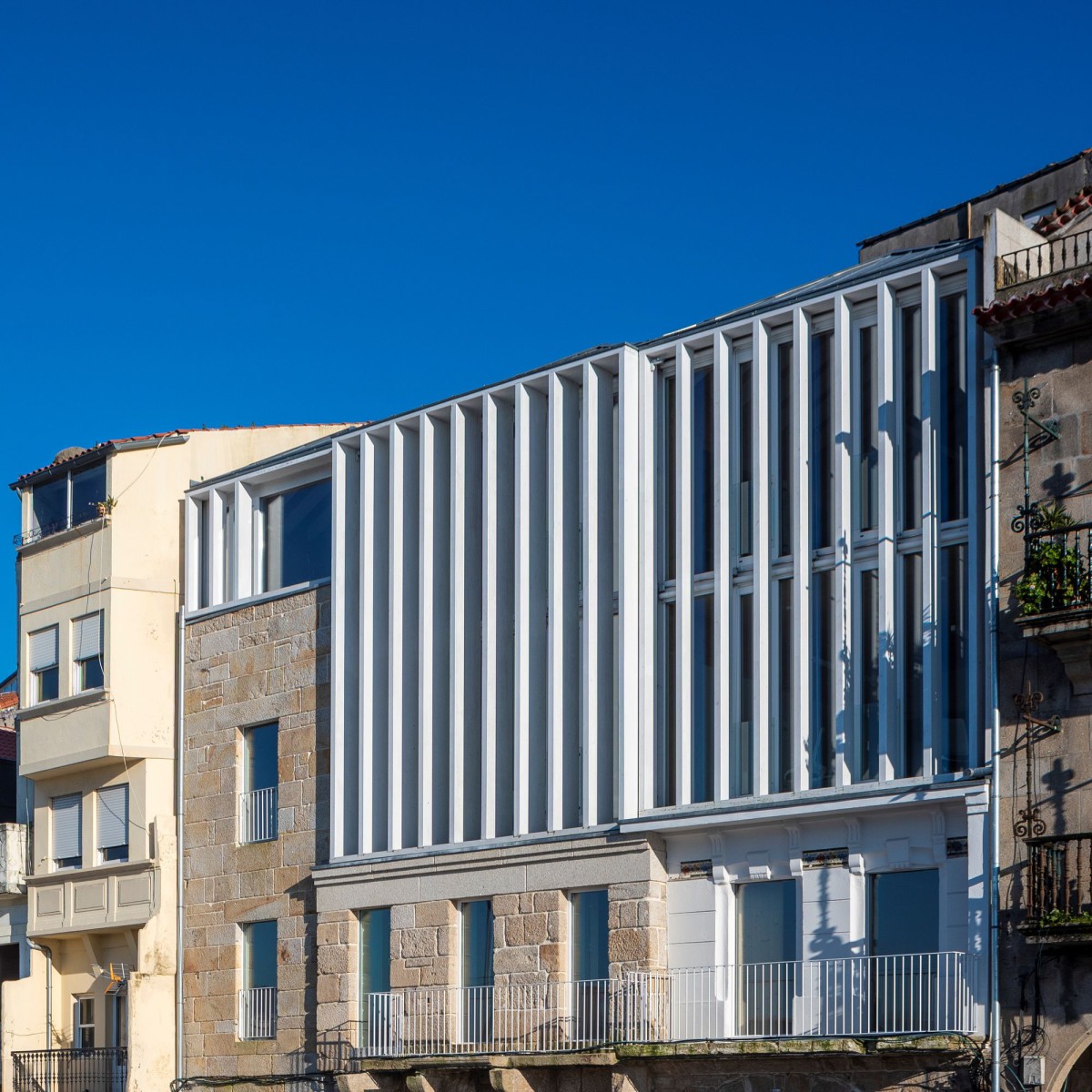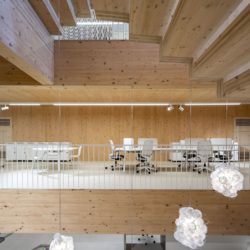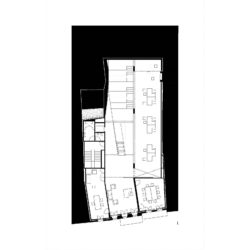abalo alonso arquitectos . fotos: © Santos Diez / Bisimages
The main campus of the University of Vigo is 10km from the urban center, and with the purpose of expanding its activity, the institution decided to refurbish three buildings in the city.
A wood volume rests on the stone supports, which are the only existing remains, preserving part of the facades and dividing walls of the old constructions. The wood box is entirely wooden, structure and construction included, but with industrialized systems that optimize the use of the material and its performance over time. The project is inspired by traditional shipbuilding, incorporating the latest R&D advances, as corresponds to the building´s use.
The choice of material and its construction system chosen help blend the building with the local tradition without giving up a certain dose of contemporaneity. The porticoes and sections of the stone façade are restored on the western front. The arches support the new construction, whose foundation is completed with micro piles along the central area, stone lab on part of the perimeter and rock directly at the rear. Before the port infills the terrain was right by the sea, so it is geologically complex.
Three criteria guide the intervention on the facades, taking the original ones as reference. The northern one is reconfigured, reusing its own stones, to adapt an existing attic. The central one is reinforced and completed with a new stone cornice similar to the existing one. And in the last one the plasters are restored with tile insertions.
The permitted height is completed with a latticework of laminated timber columns that includes structure and sun protection with the vertically suggested by the regulations and the image of an institutional building. The east façade, located between small squares, courtyards and alleys, is similarly resolved, and made lighter by the reduction of solar impact. The planned volume is achieved by rounding off the complex with three zinc hip roofs, pierced by two skylights that fill the interior with northern light.
The functional program is flexible, with spaces for work, meeting, exhibition, etc, arranged over two levels. Of the old plot arrangement, whose footprint it preserves, the smaller volume houses servicing spaces: listed staircase, restrooms, facilities on the top floor, but also a meeting room in each of the upper floors. The rest is distributed in the other two volumes, with an institutional area on the main façade of the first floor and classrooms on the second one.
_
Berbés UVigo
abalo alonso arquitectos
Sede Institucional y de I+D+i de la Universidad de Vigo.
Ribera del Berbés. Vigo
Emplazamiento: Ribera del Berbés. Vigo.
Proyecto: abalo alonso arquitectos.
Elizabeth Abalo, Gonzalo Alonso.
Dirección de obra: abalo alonso arquitectos.
Elizabeth Abalo, Gonzalo Alonso.
Arquitecto técnico: José Luis Pardo
Colaboradores: Carlos Bóveda. Cálculo de estructuras.
Gaia Enxeñería. Cálculo de instalaciones.
Spotlux. Manuel M. Carazo. Asesoría iluminación.
Cis Madeira. Manuel Touza, Azahara Sólan. Asesoría madera.
Pemade. Control de calidad estructura de madera.
Promotor: Universidade de Vigo
Construcción: Arias Infraestructuras
Industriales: Estructura de madera: Madergia.
Carpintería exterior: Carpintek.
Iluminación ornamental: Arturo Alvarez.
Techos acústicos: Maderas del Noroeste
Pavimentos de pvc: Gerflor.
Suelo técnico: Matrics.
Fin de obra: 10.06.2020
Presupuesto total: 1.461.000€
Superficie construida: 1.450 m2
Fotografía: Santos Diez / Bisimages
La universidad de Vigo, cuyo campus principal se encuentra a 10km del centro urbano, propone la rehabilitación de tres construcciones en el casco histórico con el fin de acercar su actividad al resto de la sociedad. Un volumen de madera se apoya en los soportales de piedra existentes. Una caja dentro de otra; madera y piedra. En este caso, la caja de madera es entera de madera; estructura y construcción incluidas. Pero con sistemas industrializados contemporáneos, que optimizan el uso del material y su respuesta temporal. Nos inspiramos en la construcción naval tradicional, pero incorporamos los últimos avances en i+d, como corresponde al destino del edificio que pretendemos desarrollar. La elección del material y su sistema constructivo nos permite integrarnos en la tradición local sin renunciar a cierta dosis de contemporaneidad. En el alzado oeste restauramos los soportales de piedra y las partes de fachada del mismo material que todavía se conservan. Se completa la altura permitida por el plan especial con una celosía de pilares de madera laminada que integra estructura, protección solar e imagen en un solo elemento, con la verticalidad sugerida por la normativa y la impronta de un edificio institucional como el que nos ocupa. La fachada este, incrustada entre las plazoletas, patios y callejuelas interiores, se resuelve de una manera similar, algo más aligerada por la reducción del impacto solar. Se agota la volumetría prevista en la normativa, rematando el conjunto con tres cubiertas longitudinales a cuatro aguas de zinc, perforadas en la zona central con dos lucernarios que inundan de luz norte el interior. Programa funcional flexible con espacios de trabajo, reunión, exposición, información o aulas, que se distribuyen en las diferentes plantas. Del antiguo parcelario, cuya huella se conserva, el volumen más pequeño acoge los espacios servidores. El resto se distribuye en los otros dos.


























